Couples therapy notes

Couples therapy notes are a necessity for many therapists but like relationships they’re not always easy. They take work.
Summary
- Writing notes for couples therapy is more complicated than individual therapy due to dual perspectives, confidentiality concerns, and unclear client identification—especially when insurance is involved. Download my free notes templates.
- Effective notes should include client/session details, session themes, therapist interventions, observations of interaction dynamics, and a plan for future sessions, including homework.
- Therapists must obtain consent from both partners, avoid taking sides in both sessions and documentation, and handle individual sessions within couples therapy carefully to maintain trust and objectivity.
- Notes should reflect the therapeutic model used (e.g., Gottman Method or EFT) and reference key concepts to document rationale, track progress, and support communication among care providers. An EHR like TheraPlatform can help therapists keep notes organized and accessible.
Streamline your practice with One EHR
- Scheduling
- Flexible notes
- Template library
- Billing & payments
- Insurance claims
- Client portal
- Telehealth
- E-fax

Couples therapy notes vs. individual (and group) therapy notes
Sometimes, couples have serious troubles that require professional assistance and couples therapy is an effective way to help solve many problems that partners encounter.
But couples therapy is a much different experience for the therapist than individual therapy. You are getting two points of view instead of just one. And much of the time, those perspectives differ wildly.
Similar to group therapy, the therapist is as interested in the interaction between the couple as they are in the content of what they are saying. Unlike group therapy, however, you are dealing with the couple as a unit rather than a bunch of individuals who don’t know each other outside of treatment.
While it is very helpful for a therapist to get both sides of a story, it does present some complications in writing couples therapy notes. For instance, something seemingly as simple as naming the identified client can be a difficult undertaking. Let’s take a closer look at what needs to be included in a couples therapy note.
What to include in a couples therapy note
Client and session information
This section sounds straightforward but can be tricky. Certain items, such as the date, time, and duration of the session are easily determined. The difficulty lies in choosing what client information to include.
The therapist has a few options when deciding who to name as the identified client.
- The first option is to name one member of the couple as the client in your couples therapy note and refer to the other person without using identifying information.
- The second option is to have both members of the couple as individual clients with two separate charts.
- The third option is to lump them together as one unit, identifying both as a client but with one chart.
The choice is partly the personal preference of the therapist but is also affected by whether the couple is using insurance and whether they are in a committed relationship. Insurance companies often don’t cover couples therapy as a treatment modality, so the therapist must identify one member of the couple as the client and call it family therapy. In those cases, you won’t want to explicitly name both members of the couple as clients in a therapy note.
Further, if a couple isn’t in a committed relationship, or is struggling with staying together, they may not want both of their names and information in the same note due to confidentiality issues. The easiest situation for a therapist is if the couple is committed and isn’t using insurance. In those cases, the therapist can usually handle the client’s information as they prefer.
Themes
This section talks about what topics were discussed in the session and how they relate to progress on the couple’s objectives. It concentrates on content rather than process. This part of the note answers the question, “How is the couple doing towards meeting their treatment goals?”
Interventions
It is recommended that one part of the couples therapy note focuses on the therapist’s interventions in a particular session. This will highlight what techniques the therapist used and whether or not they appeared to be effective. If you are using a GIRP or BIRP note format, for instance, this is already built into the structure of the note.
Observations
This part of the couples therapy note includes the objective and subjective impressions of the couple’s interactions. This section of couples therapy notes is just as important as the content of what is being discussed. There may be nothing more valuable than seeing the couple’s dynamics play out right in front of you.
Observing the couple in action gives you a window into their everyday life.
Plan
The last part of a couples therapy note involves what is going to happen next. For example, when is the next session, and what is the plan for therapy going forward? Almost all types of couples therapists give homework as a way to promote progress and that is noted in this section as well.
Practice Management + EHR + Telehealth
Manage more in less time in your practice with TheraPlatform
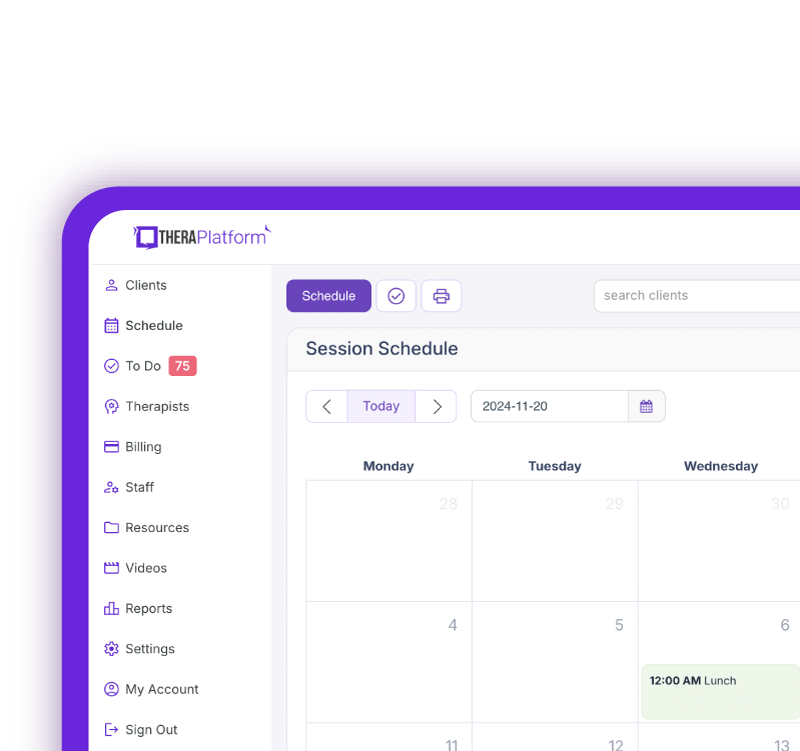
Therapist tips for writing couples therapy notes
Confidentiality
Earlier, we discussed the choices a therapist faces as to who will be the identified client in a couples therapy note. Whoever it is, the therapist must tell both members of the couple how they are handling their notes and get their consent. This will prevent any surprises later if there are insurance problems or if another professional wants to see the notes. The confidentiality of both members of the couple must be preserved, even if only one of them is the identified client.
Don’t take sides
When you are hearing two sides of a story, there is a natural inclination to lean toward one person or the other. The therapist must remain the voice of objectivity so they don’t alienate either member of the couple. This is also true in the notes, where the therapist must try to refrain from biased judgments.
Seeing one client
At times, a therapist might want to see one member of a couple without the other. This might be for assessment purposes or at the request of the client. The decision to meet with only one member of the couple is up to the therapist’s discretion. Some therapists refuse to do it because it threatens their objectivity and injects potential bias into the therapy.
If the therapist does see only one client, they need to let the other member of the couple know that this is occurring and give them the same opportunity. The therapy note needs to make clear that only one person is being seen and it will be treated more like an individual progress note.
If the person being seen is not the identified client, and the couple has been using insurance, the individual may have to pay out-of-pocket for that session or use their own insurance and open up a separate file.
Incorporate theory
Couples therapy is based upon particular theoretical orientations. The most popular theories are emotionally focused couples therapy and the Gottman method. Your notes should make clear what type of therapy you are practicing by referring to specific interventions or terminology associated with that theory.
For example, your notes might mention “the four horsemen” when employing the Gottman method. Discussing theory lets you (and your client) know what you have attempted as an intervention and allows other professionals to see what has been done so they can treat your client accordingly.
- The Couples Psychotherapy Progress Notes Planner, 2nd Edition, is an excellent resource for everything you need to know about couples notes. It comes complete with numerous templates and examples to make writing couples’ progress notes a breeze.
Watch this video to learn how to simplify note taking
→ Start My Free Trial
→ Start My Free Trial
Improving notes with EHR software
EHR software and practice management tools, such as TheraPlatform, offer numerous advantages in creating accurate, efficient, and organized notes.
Top 7 benefits of using EHR for notes management
Manually writing and storing notes can be cumbersome for many therapists. That process can be further exacerbated by simple document requests that include locating, faxing or scanning documents.
Features like customizable templates, secure storage, easy sharing, duplication, electronic signatures, and efax integration, streamline the note process, optimizing therapy documentation and workflows.
- Consistent notes with template library: EHRs equipped with a library of note templates enable therapists to create standardized and concise notes quickly. This feature ensures consistency across notes, making it easier to review client progress. Additionally, EHRs provide centralized storage and management of notes, enhancing accessibility and organization.
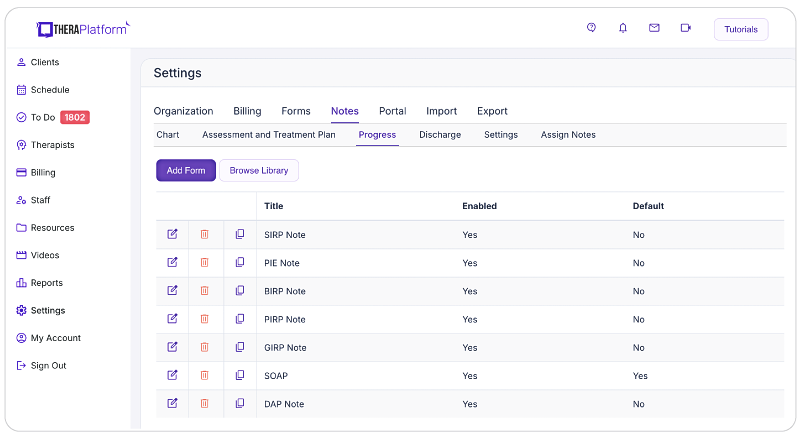
- Customizable notes: Not all EHRs offer customizable note templates tailored to therapists' unique needs. However, with a robust and user-friendly note template builder, therapists can customize note templates to align with their preferred note-taking style. This flexibility allows for efficient data entry, whether therapists prefer separating sections or using a single note field or checkboxes for mental status or techniques.
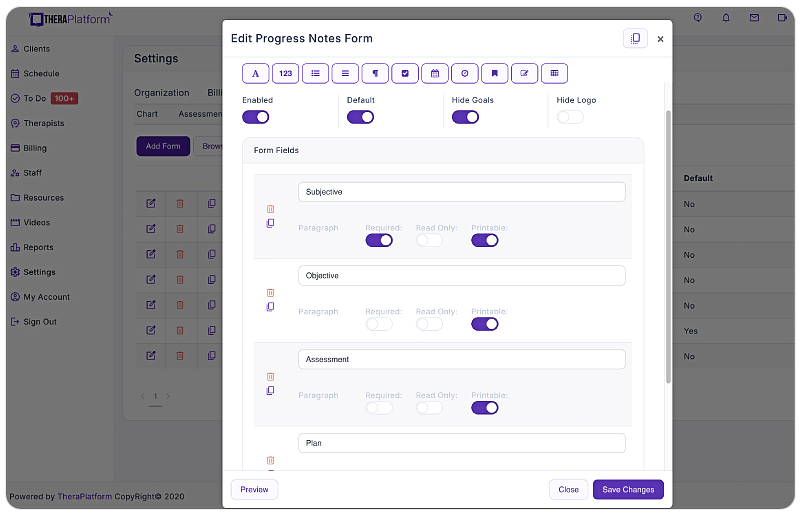
- HIPAA-compliant note storage: EHRs prioritize data security by implementing bank-level encryption to safeguard notes and other client information. TheraPlatform, for instance, ensures HIPAA compliance by offering signed, legally-binding Business Associate Agreements to protect Protected Health Information (PHI) between compliant entities.
- Seamless note sharing with clients: Clients may request access to their notes to better understand their treatment or keep them for record-keeping purposes. Using an EHR, therapists can securely share notes with clients, saving time compared to paper-based practices. TheraPlatform, a HIPAA-compliant EHR for therapists, facilitates secure note sharing with clients.
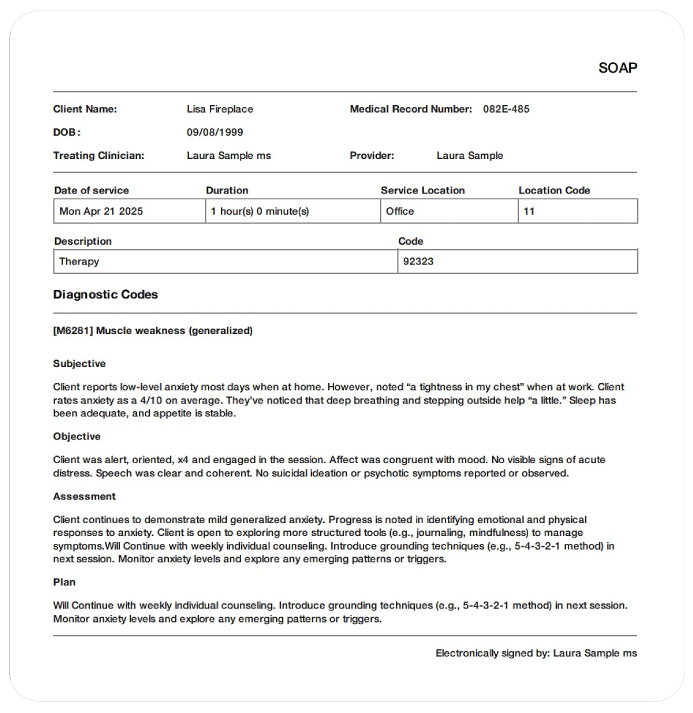
- Duplicate notes: In cases where the data remains the same across multiple sessions, duplicating notes can save time. This feature is particularly useful when clients exhibit repetitive behaviors or show minimal progress, allowing therapists to refer back to previous notes for accurate documentation.
- Client signatures made easy: EHRs streamline the process of requesting client signatures. TheraPlatform's Pro and Pro Plus plans enable therapists to request electronic signatures directly on notes. Clients can conveniently download and print the documents requiring their signatures.
- Easier faxing: TheraPlatform offers efax integration as an add-on feature, eliminating the need for toggling between multiple services. This integrated solution allows therapists to send and receive documents, including notes, via fax directly from TheraPlatform. Additionally, received faxes can be easily filed under the respective client's charts.
By leveraging the capabilities of EHR software like TheraPlatform, therapists can enhance the accuracy, efficiency, and accessibility of their notes, allowing them more time to enhance client care.
Additional tools to help with data collection and progress monitoring
Therapists can also take advantage of EHRs (such as TheraPlatfrom) that offer integrations with Wiley treatment planners to ensure consistent data collection on progress from session to session. The best part about partnering with a modern EHR is the time you save on formulating the actual notes and scoring.
What is Wiley Treatment Planner?
Wiley Treatment Planner is a widely used clinical resource designed to help mental health professionals and other therapists efficiently create treatment plans for their clients. In addition to treatment plans, the company also provides prewritten therapy notes for some diagnostic codes. It is part of the "PracticePlanners" series published by Wiley.
Features of Wiley Treatment Planner includes:
- Prewritten, evidence-based treatment goals, objectives, and interventions
- Treatment planners tailored to specific populations and problems, including adults, children, adolescents, couples, families, addictions, and more
- Alignment with the diagnostic criteria from the DSM-5 and ICD-10
- Prewritten therapy notes
Is there an online version of Wiley Treatment Planner and how can I get the Wiley Treatment Planner?
Wiley Treatment Planner company partnered with a select number of EHRs for mental health providers to make treatment planners available online. TheraPlatform’s EHR offers the Wiley Treatment Planner as an add-on for both assessment and treatment plans and therapy notes, such as notes. You can edit prewritten notes and add your own with any therapy template on TheraPlatform.
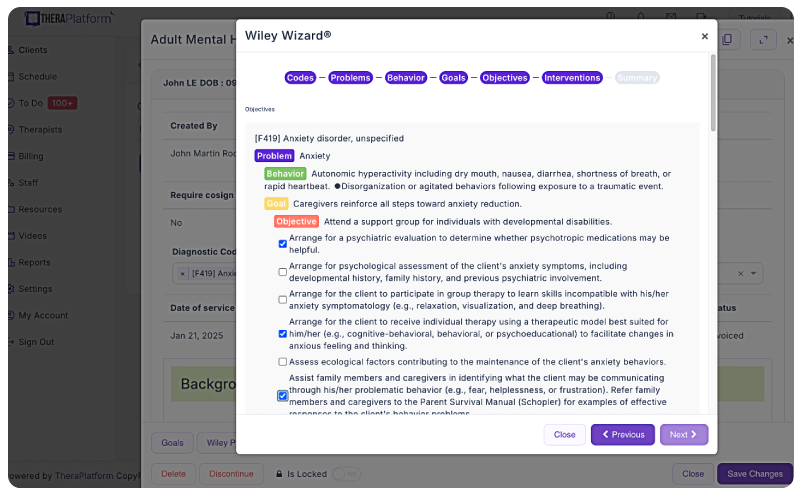
Couples therapy is a supportive resource for managing the ups and downs of relationships. However, writing notes for couples counseling has some unique features that can make it a complicated task.
By keeping in mind several suggestions, therapists can create effective couples therapy notes without spending too much valuable time.
Streamline your practice with One EHR
- Scheduling
- Flexible notes
- Template library
- Billing & payments
- Insurance claims
- Client portal
- Telehealth
- E-fax

Resources
Theraplatform is an all-in-one EHR, practice management and teletherapy solution that allows you to focus more on patient care. With a 30-day free trial, you have the opportunity to experience Theraplatform for yourself with no credit card required. Cancel anytime. They also support different industries including mental and behavioral health therapists in group practices and solo practices.
More resources
- Therapy resources and worksheets
- Therapy private practice courses
- Ultimate teletherapy ebook
- The Ultimate Insurance Billing Guide for Therapists
- The Ultimate Guide to Starting a Private Therapy Practice
Free video classes
- Free mini video lessons to enhance your private practice
- 9 Admin tasks to automate in your private practice
References
Lebow, JL, Chambers AL, Christensen A, Johnson SM. (2012) Research on the treatment of couple distress. Journal of Marital and Family Therapy, 38(1):145-68. https://doi:10.1111/j.1752-0606.2011.00249.x
Lisitsa, E. (2013, April 23). The four horsemen: criticism, contempt, defensiveness, and stonewalling. The Gottman Institute. https://www.gottman.com/blog/the-four-horsemen-recognizing-criticism-contempt-defensiveness-and-stonewalling.



